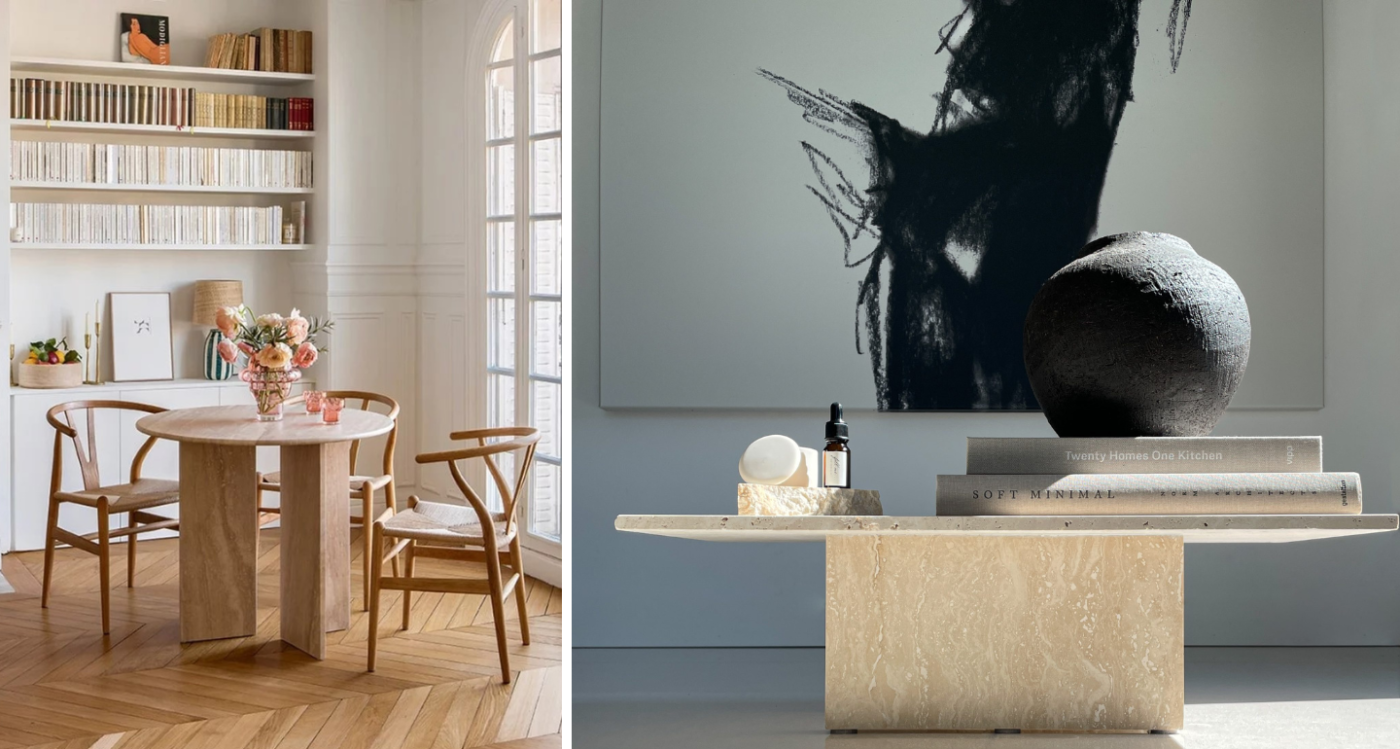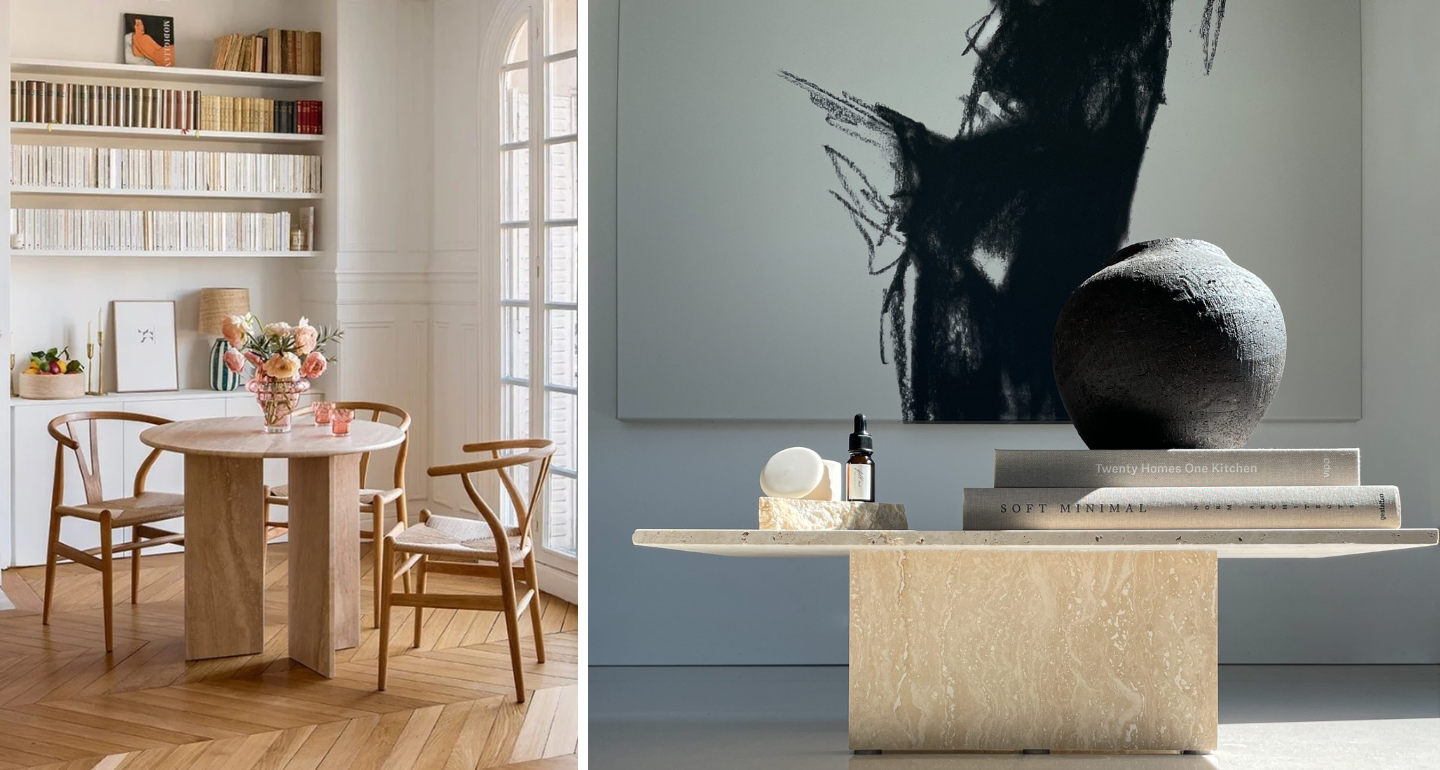Interior decoration styles vary depending on many factors, from personal tastes to the intended use of the space. Here are some interior decoration styles popular today and their main features:
1. Modern
Features: Clean lines, minimalism, functionality, light colors and wide open spaces.
Colours: White, grey, beige and neutral tones.
Materials: Glass, metal, concrete and natural stones.
Furniture: Clear acrylic furniture, flat and straight edge designs.
Featured Elements: Open spaces, few but eye-catching accessories, simple forms.
2. Industrial
Features: Raw materials, rustic details, factory style elements.
Colours: Dark grey, brown, black and metallic tones.
Materials: Briquette walls, cast concrete, metal and wood.
Furniture: Vintage and recycled furniture, open pipe systems.
Featured Elements: Exposed brick walls, large windows, metal shelving.
3. Classic
Features: Rich and detailed decorative elements, symmetry, luxurious materials.
Colours: Cream, gold, deep green, burgundy.
Materials: Wood, leather, velvet.
Furniture: Ornate, carved detailed and heavy furniture.
Featured Elements: Candlesticks, large mirrors, patterned rugs.
4. Rustic
Features: Warm and comfortable atmosphere, natural materials.
Colors: Pastel tones, natural earth colors.
Materials: Wood, stone, cotton and linen.
Furniture: Old style wooden furniture, handmade pieces.
Featured Elements: Floral fabrics, rustic details, cozy pillows.
5. Scandinavian
Features: Minimalism, functionality, naturalness.
Colours: White, light grey, pastel tones.
Materials: Wood, wool, cotton.
Furniture: Plain, functional designs, simple lines.
Featured Elements: Sheer and lightweight fabrics, natural light, clean and open spaces.

6. Bohemian
Features: Free, eclectic and colorful combinations.
Colors: Vibrant and diverse colors, red, orange, purple.
Materials: Cotton, linen, ethnic fabrics.
Furniture: Vintage, handmade or ethnic pieces.
Featured Elements: Mixed patterns, comfortable seating, plenty of accessories.
7. Japanese (Zen)
Features: Simplicity, tranquility, natural elements.
Colours: Neutral tones, light brown, grey.
Materials: Wood, stone, bamboo.
Furniture: Low profile, simple designs.
Featured Elements: Natural light, minimalism, spaces integrated with nature.
8. Art Deco
Features: Sumptuous, elegant and luxurious details.
Colours: Gold, silver, pastel tones.
Materials: Responsive and metallic surfaces, mirrors.
Furniture: Geometric shapes, luxurious fabrics.
Featured Elements: Art decorative elements, metal accents, big and bold patterns.
9. Modern Farmhouse
Features: Combination of rural and industrial elements, comfort.
Colours: White, grey, natural wood tones.
Materials: Wood, metal, cotton.
Furniture: Old style wooden furniture, vintage pieces.
Featured Elements: Open shelving, natural stone accents, rustic accessories.
10. Retro
Features: Aesthetics of past periods, colorful and fun details.
Colors: Bright colors, turquoise, red, green.
Materials: Plastic, velvet, colorful patterned fabrics.
Furniture: 50s, 60s and 70s style furniture.
Featured Elements: Retro patterns, vintage accessories, classic toys.
11. Eclectic
Features: Mix of various styles, personal touches.
Colors: Various and rich colors.
Materials: Mixed materials, vintage and modern pieces.
Furniture: Furniture from different periods and styles.
Featured Items: Personal collections, creative combinations, eye-catching accessories.
These styles offer a wide range of options for interior decoration to suit various tastes and needs. Each style has its unique elements and characteristics, so it is important to choose the right style by considering the purpose of the space and personal preferences.
The Importance of Using Marble in Interior Decoration
Marble holds an important place in interior decoration due to its elegance, sophistication, and durability. Used since ancient times as both a luxurious and functional material, marble remains a popular choice in modern designs. Let’s take a closer look at the importance of marble and its applications in interior decoration:
1. Aesthetic and Luxurious Appearance
Marble is a visually rich, elegant, and sophisticated material. The natural veining and color transitions on its surface make each piece of marble unique. This creates a visual impact in interior spaces, almost like a work of art. Marble comes in a variety of colors such as white, gray, green, black, and pink, offering a wide range of possibilities in design.
- Elegance and Sophistication: Marble symbolizes elegance and sophistication, especially in luxurious interiors. For example, in hotel lobbies or upscale restaurants, marble is an element that enhances the prestige of the space.
2. Durability and Longevity:
Marble is a remarkably hard and durable material. This quality makes it a long-lasting option for interior spaces. With proper care, marble can withstand the test of time and remain in excellent condition for many years.
- Hardness and Durability: Its high durability makes marble an ideal choice for frequently used areas such as kitchen countertops, floors, and bathroom surfaces. Marble surfaces are highly resistant to wear and abrasion.
3. Versatile Applications:
Marble provides both aesthetic appeal and functionality across various areas. It offers a wide range of surfaces and applications, including:
- Floors: Marble flooring is especially favored in spacious living rooms and luxurious hotel lobbies. Marble floors reflect light, creating a bright and airy atmosphere within the space.
- Countertops: In kitchens and bathrooms, marble offers a solution that is both functional and aesthetically pleasing. It is easy to clean and resistant to water, making it a practical choice for everyday use.
- Walls: Marble is often used as a decorative element on walls, especially in modern designs. It is frequently chosen in bathrooms as an application that enhances elegance and sophistication.
- Accessories and Furniture: Marble can also be used in smaller accessories such as coffee table tops, lamps, and frames. Its sturdy structure allows for the creation of durable and stylish pieces.
4. Heat and Sound Insulation:
Marble is a material that conducts heat well, which can be advantageous especially in cold climates. Additionally, due to its sound insulation properties, it helps prevent the spread of noise and can improve the acoustic quality of a space.
5. Natural and Environmentally Friendly Material:
Since marble is a natural stone, it is considered an environmentally friendly material. The use of natural stone is an attractive choice for those who prioritize organic and ecological designs.
- Sustainability: Marble is a long-lasting material that does not require frequent replacement or renewal over time, making it an environmentally friendly choice.
6. Rich Texture and Pattern Options:
Marble brings a unique look to a space with its natural veins and patterns found in nature. These designs, combined with various color and texture options, harmonize well with both modern and classic styles.
- Patterns: Gray veins on white marble, black and gold-colored patterns, or marble in green and cream tones allow for the creation of diverse aesthetic forms in interior spaces.
7. The Beauty of Marble Aging Over Time:
Marble becomes more beautiful over time as it develops a patina through use. In other words, an aged marble surface adds character, while new and polished marble surfaces offer their own distinct elegance. This quality especially gives a sense of increasing value to marble over the years, particularly in classic designs.
8. Compatible with Different Styles:
Marble is compatible with both modern and classic decoration styles. It can be incorporated into minimalist as well as traditional designs. For example, a sleek marble countertop can be used in a modern interior, while detailed marble fireplaces or elegant columns are preferred in classic designs.
- Classic Style: Marble is especially ideal for classic and elegant designs. Antique marble sculptures or large-scale marble floors add a luxurious and historical atmosphere to a space.
- Modern Style: In modern interiors, simpler and more minimal marble applications are preferred. For example, marble with subtle veining creates a clean yet elegant effect.

